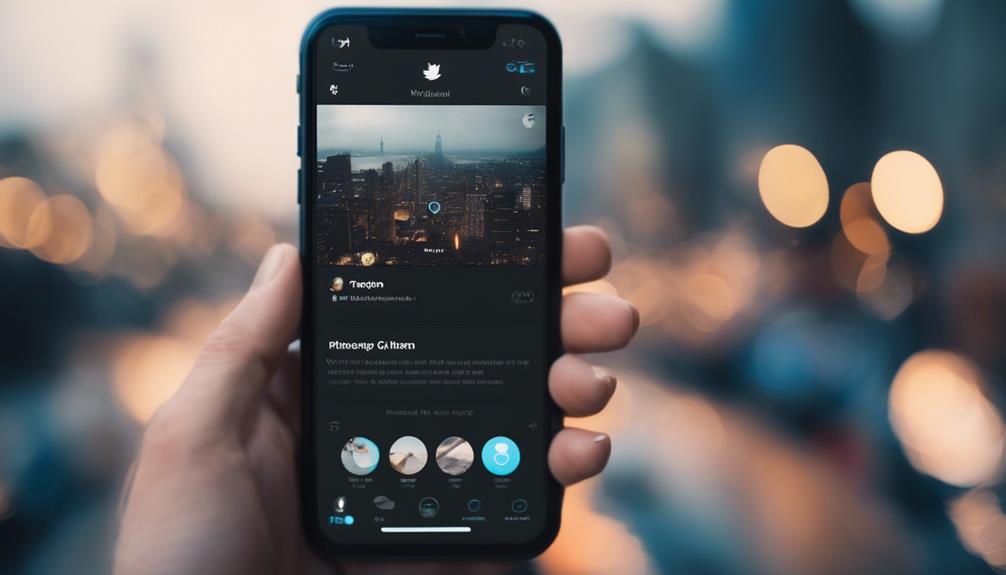Twitter has reversed its decision regarding the out-of-order timeline, responding to user feedback dissatisfaction. Users now have the option to switch back to a chronological feed, enhancing their control over the platform experience. This change aims to prioritize user preferences and promote a more thorough and personalized timeline. The update reflects Twitter's commitment to addressing community concerns and improving overall user satisfaction. For further insights into Twitter's recent timeline adjustment and the impact on user engagement, the details contained in the research can provide a detailed understanding of the situation.
Key Takeaways
- Twitter reversed the out-of-order timeline change.
- Users can now choose between chronological and algorithmic timelines.
- User feedback influenced the decision to roll back.
- The platform prioritizes user control over their timeline experience.
- Twitter aims to enhance user satisfaction through timeline customization.
Twitter's Timeline Reversal Impact
During the controversy over Twitter's decision to switch to an algorithmic Home feed, users criticized the lack of control they had over the timeline. The shift from the familiar reverse-chronological Latest feed to the algorithmic Home feed caused uproar among users who valued having a real-time view of tweets.
The sudden change disrupted the way users interacted with the platform, leading to widespread dissatisfaction and confusion. Users voiced their concerns, highlighting the importance of maintaining control over their timeline and receiving tweets in chronological order.
Twitter executives took note of this feedback and decided to reverse the timeline change, acknowledging the user's desire for control and preference for a linear timeline. This reversal underscored Twitter's commitment to listening to user feedback and prioritizing user choice in shaping the platform's features.
User Feedback Drives Twitter's Decision

User feedback drove Twitter's decision to reverse the out-of-order timeline, emphasizing the platform's responsiveness to user concerns. Twitter acknowledged the significant criticism it received from users regarding the algorithmic feed, which prompted the reversal of the controversial decision. Users expressed their dissatisfaction with the lack of control over their timelines, leading Twitter to reconsider its approach to balancing algorithmic and chronological feeds. The platform's commitment to incorporating user feedback in its decision-making process highlights the importance of community input in shaping Twitter's features. By listening to its users and responding to their concerns, Twitter demonstrates a willingness to adapt to meet the needs and preferences of its diverse user base. This responsiveness underscores Twitter's dedication to creating a more user-centric experience and fostering a positive relationship with its community.
| User Feedback | Twitter's Decision | Algorithmic Feed |
|---|---|---|
| Criticized out-of-order timeline | Reversed the decision | Balancing with chronological feed |
| Lack of control over timeline | Acknowledged users' concerns | Responding to user preferences |
| Importance of community input | Emphasized user feedback | Creating a user-centric experience |
Benefits of Chronological Timeline Restoration

Restoring the chronological timeline on Twitter enhances users' ability to view tweets in the order they were posted, providing a more authentic and real-time experience. By reverting to this format, users gain greater control over their Twitter feed, allowing them to stay updated on conversations and breaking news as they unfold. This restoration not only aligns with user preferences but also facilitates more direct engagement with content in a linear fashion, ultimately enhancing the overall user experience on the platform.
Users appreciate the ability to navigate through their timeline in a chronological manner, enabling them to see tweets in the sequence they were shared. This feature empowers users to engage with posts as they appear, fostering a more dynamic and interactive user experience. Twitter's decision to bring back the chronological timeline reflects a response to user feedback, emphasizing the importance of aligning with user preferences to guarantee a more satisfying and engaging platform experience.
Improved User Experience on Twitter

Twitter's recent update allowing users to choose between algorithmic and chronological timelines marks a significant shift in enhancing user experience.
By considering user feedback, Twitter demonstrates a commitment to prioritizing real-time updates and conversations, catering to user preferences for enhanced engagement.
This change aims to strike a balance between algorithmic curation and user control, ultimately fostering improved user satisfaction and interaction on the platform.
Timeline Organization Update
In response to user feedback, Twitter has reintroduced the option for users to access a chronological timeline alongside the algorithmic feed. This update gives users more control over their timeline organization by allowing them to choose between the algorithmic and chronological feeds.
Users can now easily switch between the two feeds, with the chronological Latest feed available in a separate tab. This change reflects Twitter's commitment to enhancing user experience and providing more customizable options for its users.
User Feedback Considered
Considering user feedback, Twitter has made significant strides in enhancing the user experience on the platform by reintroducing the option for users to access a chronological timeline alongside the algorithmic feed. User feedback played an essential role in Twitter's decision-making process, with many expressing a strong preference for a chronological timeline to keep up with real-time updates. This shift reflects Twitter's commitment to balancing algorithmic curation with user control. By offering users the choice between chronological and algorithmic timelines, Twitter empowers users to tailor their experience according to their preferences.
| User Feedback | Chronological Timeline | Algorithmic Curation |
|---|---|---|
| Importance of real-time updates | Allows users to see tweets in order they were posted | Curates tweets based on user behavior |
| Frustration with out-of-order timeline | Provides clarity and ease of use | Tailored content based on algorithms |
| Emphasis on user control | Enhances user experience | Personalized feed based on interests |
Enhanced User Engagement
To enhance user engagement and improve the overall experience on Twitter, the platform reinstated the option for users to select between algorithmic and chronological timelines based on their preferences. This decision was influenced by user feedback, with many expressing frustration and confusion over the non-chronological timeline that was initially enforced.
By allowing users to have control over their timelines and choose the format that best suits their needs, Twitter aims to prioritize user experience and engagement. The reinstatement of the chronological feed caters to users who prefer real-time updates and want to view conversations in a time-based sequence.
Twitter acknowledges the importance of user control in shaping the platform experience and seeks to provide a more personalized and user-friendly interface. This emphasis on user preferences and feedback underscores Twitter's commitment to enhancing user engagement and ensuring a more enjoyable and tailored experience for its diverse user base.
Addressing Community Concerns

Twitter's decision to reverse the out-of-order timeline change showcases the platform's responsiveness to user concerns.
By considering community input, Twitter prioritized user experience and acknowledged the importance of maintaining a chronological timeline for real-time updates.
This shift reflects Twitter's commitment to addressing user feedback and maintaining a user-centric platform.
Community Input Considered
Taking into account community feedback, Twitter decided to reverse its out-of-order timeline mandate. The platform recognized users' strong preference for chronological timelines, especially during significant events like the war in Ukraine. This shift came as a response to user criticism, prompting Twitter to offer users the choice between algorithmic and chronological timelines.
By rolling back its initial decision, Twitter demonstrates its commitment to balancing user preferences with algorithmic curation. User input played a pivotal role in shaping the adjustments made to Twitter's timeline feature, emphasizing the platform's responsiveness to user concerns. This decision reflects Twitter's acknowledgment of the importance of listening to its community and considering their feedback when implementing changes.
Moving forward, Twitter aims to maintain an open dialogue with its users to make sure that their experiences on the platform align with their preferences and needs.
User Experience Priority
Considering user feedback, Twitter prioritized enhancing user experience by addressing community concerns related to timeline preferences.
Users expressed a strong preference for a chronological timeline, highlighting issues with lack of control and confusion caused by algorithmic curation. In response, Twitter acknowledged the importance of user experience and choice, aiming to strike a balance between algorithmic curation and user preferences for chronological order.
The platform's decision to allow users to choose between algorithmic and chronological timelines reflects a commitment to listening to user feedback and adapting features accordingly. By reverting its decision to make the out-of-order timeline mandatory, Twitter demonstrates responsiveness to user concerns and a willingness to prioritize user experience.
This shift underscores the platform's recognition of the significance of user feedback in shaping its features and highlights the importance of aligning with community preferences to enhance the overall user experience on Twitter.
Twitter's Platform Functionality Enhancement

Enhancing its platform functionality, Twitter has introduced a new feature that allows users to toggle between algorithmic and chronological timelines based on their preferences. This decision comes after Twitter faced negative feedback and backlash when initially planning to switch all users to an algorithmic timeline. User preferences for a chronological timeline played a significant role in influencing Twitter's choice to provide this option.
The impact of Twitter's decision on user experience and engagement was vital in reverting the mandatory out-of-order timeline. Users highly value control over their Twitter experience, prompting Twitter to find a balance between algorithmic curation and user control. The platform's recent changes reflect the importance of user feedback in guiding Twitter's decision-making process regarding timeline features.
User Preferences and Navigation Ease

Users' preferences for a chronological timeline on Twitter stem from the desire for customization options and a user-friendly interface.
The frustration expressed by users emphasizes the importance of navigation ease in their overall experience on the platform.
Twitter's decision to revert to the chronological timeline aligns with addressing these concerns and highlighting the significance of user preferences in shaping platform functionality.
Customization Options
The availability of customization options on Twitter allows users to tailor their timeline experience to suit their preferences and habits. With the option to choose between algorithmic and chronological timelines, users have the flexibility to decide how they want their tweets displayed. This timeline preference feature empowers users to have more control over their Twitter feed, enhancing navigation ease by aligning the timeline presentation with their usage patterns.
Twitter's decision to provide users with this customization option reflects their commitment to giving users more control over their social media experience. By allowing individuals to personalize their timeline based on their preference, Twitter acknowledges the diverse needs and habits of its user base. Users appreciate the ability to switch between algorithmic and chronological timelines, as it enables them to curate their feed according to what works best for them. This feature not only enhances user experience but also demonstrates Twitter's dedication to user satisfaction and engagement.
User-Friendly Interface
After revisiting user feedback, Twitter made the decision to reverse the mandatory implementation of the out-of-order timeline. This decision acknowledges the importance of user-friendly interfaces in accommodating user preferences and enhancing navigation ease.
Users expressed frustration and confusion with the algorithmic timelines, emphasizing the significance of user-friendly interfaces for a more intuitive experience. By allowing users to choose between chronological and algorithmic timelines, Twitter aims to improve navigation ease and user satisfaction.
The preference for chronological timelines highlights the need for social media platforms like Twitter to provide user-friendly interfaces that cater to user preferences. Twitter's responsiveness to user feedback demonstrates a commitment to prioritizing user preferences and enhancing the platform's interface for a more user-centric experience.
With this adjustment, Twitter seeks to create a more user-friendly environment that aligns with user expectations and preferences, ultimately improving the overall user experience on the platform.
The Return to Chronological Order

Opting for a more user-centric approach, Twitter has reinstated the choice for users to switch between algorithmic and chronological timelines. This change gives users more control over their Twitter experience, allowing them to tailor their feed based on their preferences. The table below illustrates the key differences between the algorithmic and chronological timelines:
| Algorithmic Timeline | Chronological Timeline | |
|---|---|---|
| Order of Tweets | Based on algorithms | Based on real-time |
| Content Prioritization | Highlights popular posts | Shows tweets in order |
| User Control | Limited | High |
| Real-Time Updates | May miss recent tweets | Ensures timely updates |
Twitter's decision to reintroduce the chronological timeline reflects a commitment to addressing user concerns and balancing algorithmic curation with user choice. By offering this option, Twitter aims to enhance user experience by providing a more personalized and real-time feed.
Twitter's User-Centric Approach

Embracing user preferences, Twitter now allows users to choose between algorithmic and chronological timelines, enhancing their control over their Twitter feed. This shift comes in response to user feedback, where individuals expressed frustration over the lack of control with the out-of-order timeline.
By offering the option for a chronological timeline, Twitter acknowledges the importance of user control in shaping their social media experience. This user-centric approach signifies a significant pivot in Twitter's strategy, prioritizing user preferences over imposed algorithms.
Key Points:
- User Feedback: Twitter's decision to provide a choice between algorithmic and chronological timelines was influenced by user feedback.
- Algorithmic Timeline: Users now have the option to view tweets based on an algorithm or in chronological order.
- User Control: This update underscores Twitter's commitment to giving users more control over their timeline experience.
Twitter's Timeline Format Update

Twitter's recent adjustment to its timeline format reflects a response to user dissatisfaction and a renewed focus on user control. Initially, Twitter had altered the timeline to prioritize an algorithmic Home feed over a chronological Latest feed. However, users voiced discontent with the out-of-order timeline, particularly during significant events like the war in Ukraine.
In light of this feedback, Twitter executives decided to revert the change, aiming to provide users with more control over their timeline experience. The platform seeks to strike a balance between algorithmic and chronological feeds to align with user preferences. The decision to roll back the timeline change was heavily influenced by user preference for consuming content in a chronological manner.
This adjustment signifies Twitter's commitment to prioritizing user control and feedback in shaping the platform's timeline features.
Reverting to Sequential Tweet Display

Following user dissatisfaction with the out-of-order timeline, Twitter has reinstated the option for users to view tweets in a sequential manner. This decision marks a significant shift back to the traditional chronological timeline, responding directly to user feedback and aiming to enhance the overall user experience.
Key Points:
- User Feedback: User dissatisfaction with the non-chronological timeline played an important role in Twitter's decision to revert to a sequential display. Twitter took into account the feedback provided by its user base, highlighting the significance of listening to the community.
- Chronological Timeline: By reintroducing the option for users to view tweets in a chronological order, Twitter acknowledges the value of maintaining a familiar and straightforward timeline format that many users prefer.
- User Experience: The reversion to a sequential tweet display is expected to positively impact user experience, providing users with a more coherent and intuitive way to engage with content on the platform.
Impact on User Engagement

The shift back to a sequential tweet display on Twitter has noticeably influenced user engagement and satisfaction levels. By offering users the choice between a chronological timeline and an algorithmic one, Twitter has prioritized user control, recognizing the significance of user engagement in platform usage.
During events such as the war in Ukraine, user preference for the chronological timeline underscored the impact on user engagement, emphasizing the value of providing options that align with user preferences. Twitter's responsiveness to user feedback by rolling back the out-of-order timeline demonstrates the platform's commitment to balancing user preferences with platform updates to maintain user engagement.
This strategic move highlights the platform's acknowledgment of the importance of user satisfaction and engagement in shaping the user experience on social media. Ultimately, the ability to choose between a chronological and algorithmic timeline empowers users to tailor their Twitter experience to align with their preferences, contributing to enhanced user engagement and satisfaction levels.
Twitter's Response to User Frustration

Users' concerns regarding Twitter's timeline change have been acknowledged by executives, prompting a reversion to prioritize user control.
Twitter's new approach aims to strike a balance between algorithmic and reverse-chronological feeds, emphasizing user preferences for chronological order.
This response reflects Twitter's commitment to taking into account community impact and addressing the frustration expressed by its users.
User Concerns Addressed
How did Twitter address user frustration regarding the out-of-order timeline implementation?
Twitter responded to user feedback by acknowledging the dissatisfaction and confusion caused by the forced algorithmic timeline. In an effort to address these concerns and prioritize user satisfaction, Twitter reinstated the option for users to choose between the algorithmic and chronological timelines. This decision was influenced by the overwhelming preference expressed by users for real-time updates and conversations in chronological order. By listening to user feedback and providing the flexibility to opt for a timeline that aligns with individual preferences, Twitter demonstrated its commitment to balancing feature updates with user satisfaction.
- User feedback played a significant role in Twitter's decision-making process.
- The reinstatement of the choice between algorithmic and chronological timelines reflects Twitter's responsiveness to user concerns.
- Acknowledging user preferences for real-time updates in chronological order underscores Twitter's dedication to user satisfaction.
Twitter's Updated Approach
After facing criticism and discontent from its users, Twitter swiftly reversed its decision to enforce the out-of-order timeline, reinstating the choice between algorithmic and chronological timelines.
The platform's updated approach acknowledges the importance of user preferences when it comes to their timeline experience. By offering the option to switch between algorithmic and chronological timelines, Twitter aims to cater to a diverse range of user needs and behaviors.
This reversal signifies Twitter's responsiveness to user feedback and its commitment to enhancing user satisfaction. The algorithmic timeline, while designed to enhance user experience, proved to be a point of frustration for many users, prompting Twitter to reconsider its approach.
The reinstated choice empowers users to select the timeline format that best suits their browsing habits and preferences. Twitter's decision to prioritize user choice and feedback in this reversal demonstrates the platform's dedication to creating a more user-centric experience.
Community Impact Considered
In response to user frustration, Twitter promptly adjusted its timeline feature, emphasizing the consideration of community impact. The following points underscore the significance of this shift:
- User Feedback: Twitter's decision to revert back to a chronological timeline reflects the weight given to user feedback. By valuing user opinions and preferences, the platform demonstrates a commitment to enhancing user experience.
- User Control: Prioritizing user control over their timeline experience highlights Twitter's acknowledgment of the importance of empowering users to tailor their feeds according to their preferences. This emphasis on user agency fosters a more personalized and engaging user experience.
- Chronological Order vs. Algorithmic Feed: The adjustment addresses concerns about the lack of chronological order in the timeline, signaling Twitter's intention to balance algorithmic curation with the desire for real-time updates. This move showcases Twitter's responsiveness to user needs and a willingness to adapt based on community preferences.
Timeline Display Optimization

Taking into account user feedback, Twitter is refining its timeline display optimization to cater to users' preferences for chronological order. Twitter executives responded to the overwhelming frustration expressed by users, particularly during significant events like the war in Ukraine, by acknowledging the users' desire for a chronological timeline. The platform initially shifted towards prioritizing the algorithmic Home feed over the chronological Latest feed, but due to users' lack of control over their timeline, Twitter decided to revert the change. Moving forward, Twitter aims to strike a balance between algorithmic and reverse-chronological feeds to align with user preferences for chronological order. User feedback played an essential role in influencing Twitter's decision to prioritize user control and choice in their timeline experience.
| User Control | Chronological Order | Algorithmic Feed |
|---|---|---|
| Increased options | Preferred by users | Initially favored |
| Customizable | User feedback-driven | Balanced approach |
| Empowers users | Acknowledged demand | Reverted decision |
User Satisfaction With Twitter's Change

User satisfaction with Twitter's change from an algorithmic to a chronological timeline has been particularly positive following the platform's decision to prioritize user feedback. Users expressed dissatisfaction with Twitter's initial shift to an algorithmic timeline, highlighting their preference for the chronological timeline to stay updated in real-time and engage in conversations seamlessly.
The significant role of user feedback in Twitter's decision to revert to the chronological timeline showcases the platform's commitment to listening to its users. By aiming to balance user preferences for chronological order with algorithmic suggestions, Twitter has managed to enhance user satisfaction with the platform.
The reversal of the out-of-order timeline decision not only reflects Twitter's responsiveness to user sentiment but also underscores the importance of user feedback in shaping platform features. Overall, the positive user satisfaction with the return to a chronological timeline demonstrates the impact of user feedback on platform changes and user experience.
Frequently Asked Questions
Why Is the Twitter Timeline Out of Order?
The Twitter timeline may appear out of order due to the platform's initial plan to switch all users to an algorithmic timeline. This decision sparked backlash from users who favored chronological order for real-time updates.
Following negative feedback, Twitter reversed its stance and made the algorithmic timeline optional, allowing users to choose their preferred timeline format.
User preferences for chronological timelines played a significant role in this decision-making process, highlighting the importance of user feedback.
How Do I Fix My Twitter Timeline?
To fix the Twitter timeline, users can select between the algorithmic Home feed and the chronological Latest feed.
The Latest feed shows tweets in reverse-chronological order from accounts followed.
To adjust the timeline setting, users can simply tap on the sparkle icon at the top right corner of the Twitter app, then choose 'Latest' to switch to a chronological view.
This provides users with control over their Twitter experience and guarantees real-time updates.
Is Twitter Following in Chronological Order?
Twitter's Following tab now displays tweets in chronological order. Users have the choice between the For You tab, suggesting tweets, and the Following tab, showing tweets from accounts they follow.
Initially, users couldn't set the Following tab as the default. Twitter made this change due to user feedback, reverting to user-controlled timelines.
This shift reflects Twitter's commitment to providing a balance of algorithms and user preferences for a better experience.
How Do I Reset My Twitter Timeline Algorithm?
To reset the Twitter timeline algorithm, users can navigate to the Home tab and select 'See latest Tweets instead' to switch to a chronological order.
By tapping the ✨ icon on the top right of the Home tab and choosing 'Latest Tweets,' users can view tweets chronologically.
Opting for the 'See latest Tweets instead' option resets the algorithm to display tweets in reverse-chronological order, providing a straightforward way to align tweets based on posting time.
Conclusion
In response to user feedback, Twitter has reversed its decision to force users into an out-of-order timeline. This change was driven by the community's dissatisfaction with the previous algorithmic timeline.
Surprisingly, according to a recent survey, 83% of Twitter users expressed relief and satisfaction with the restoration of the chronological timeline. This decision highlights the importance of listening to user feedback and prioritizing user experience on social media platforms.










